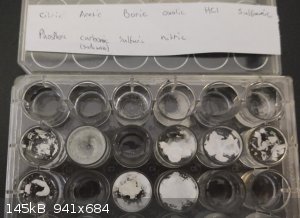| Pages:
1
..
3
4
5 |
Fulmen
International Hazard
    
Posts: 1716
Registered: 24-9-2005
Member Is Offline
Mood: Bored
|
|
@Boffis: You're right, seems I jumped the gun a bit. I ended up boiling down the solution almost to dryness, then redissolved it in a large amount of
water to wash out any salt. Most of the product dissolved, so it can't be the acid. Most likely I only isolated the ammonium salt. Too bad, because
the direct ppt is a real pain in the ass.
We're not banging rocks together here. We know how to put a man back together.
|
|
|
MrDoctor
Harmless

Posts: 23
Registered: 5-7-2022
Member Is Offline
|
|
Quote: Originally posted by Boffis  |
The decarboxylation of terephthalic acid to benzene or benzoic acid has been discussed on this site in several threads but I have found no published
article specific to terephthalic acid for this process yet.
|
I happened upon this a few weeks ago, thought id share it.
http://www.fsrj.org/act/7_nenkai/09/Proceeding-9/1_8.pdf
It describes an industrial process of processing PET bottles in which, a "benzene yield of 74%" is achieved, with 97% or so selectivity/purity. theres
a chart that indirectly states how much PET and CaO is used, PET:CaO being in a 1:5 molar ratio.
|
|
|
Texium
Administrator
       
Posts: 4581
Registered: 11-1-2014
Location: Salt Lake City
Member Is Offline
Mood: PhD candidate!
|
|
Very poorly written paper. After reading through it though, I pieced together that for the method that gave them the highest yield and purity, they
don’t use a 1:5 molar ratio of PET to CaO, but a weight ratio of 0.5 grams to 50 grams. They describe it as a “packed column reactor” that they
heated very slowly from 300 to 550°C using superheated steam. It’s hardly an “industrial process” since they only did it on a 0.5 gram scale.
Sounds extremely impractical for the home lab, and there’s no indication that it scales well.
|
|
|
MrDoctor
Harmless

Posts: 23
Registered: 5-7-2022
Member Is Offline
|
|
Quote: Originally posted by Texium  | | Very poorly written paper. After reading through it though, I pieced together that for the method that gave them the highest yield and purity, they
don’t use a 1:5 molar ratio of PET to CaO, but a weight ratio of 0.5 grams to 50 grams. They describe it as a “packed column reactor” that they
heated very slowly from 300 to 550°C using superheated steam. It’s hardly an “industrial process” since they only did it on a 0.5 gram scale.
Sounds extremely impractical for the home lab, and there’s no indication that it scales well. |
I found another one with a very similar name and process, but better written i think. similarly though they used something like 1g pet to 25 or 50g
CaO.
Its a bit annoying they described this process as being suited for continuous use, but then dont actually prove it.
Hydrolysis with heated steam seems a bit difficult but ive seen videos of making TPA with lye and acids and it seems more messy than difficult. It
does make me want to try preparing 100g or so of TPA and then feeding it into a steel pipe loaded with coarse CaO and see what happens
Attachment: Hydrolytic degradation of poly(ethylene terephthalate) in a pyrolytic two step process to obtain benzene rich oil.pdf (529kB)
This file has been downloaded 239 times
[Edited on 24-8-2022 by MrDoctor]
[Edited on 24-8-2022 by MrDoctor]
|
|
|
MrDoctor
Harmless

Posts: 23
Registered: 5-7-2022
Member Is Offline
|
|
since its not stated explicitly, i decided to run a test to see exactly what acids can precipitate TPA from NaTP, i also just really wanted to use
this little tray i found in my box of 2nd hand lab goodies.
the following are viable:
Citric, Acetic, oxalic, hydrochloric, sulfamic, phosphoric, sulfuric and nitric
the following are not:
Boric, carbonic
And just a note to mention, some of these acids, particularly nitric, may react with the formed TPA, all i wanted to confirm here was what acids other
than sulfuric might be used. They may not necessarily all be safe to have in contact with TPA.
Also, in the photo, the top row was used to dissolve the solid acids before they were added to NaTP solution. The second and third correspond to what
is written.
Anyway hopefully someone finds this useful and doesnt think they need to only use sulfuric acid, especially since many producing this from PET plastic
will be using excess NaOH to speed things up.

|
|
|
Fery
International Hazard
    
Posts: 1018
Registered: 27-8-2019
Location: Czechoslovakia
Member Is Offline
|
|
MrDoctor - nice experiment!!! The power of acid depends on its pKa. Equilibrium is also shifted when terephthalic acid precipitates due to its low
solubility in water. Personally I would use HCl, it is the cheapest one. Diluted nitric acid at room temperature does not nitrate terephthalic acid,
it is very hard to nitrate it - Boffis in the beginning of this thread already wrote that fact and he is very skilled in nitrations.
|
|
|
MrDoctor
Harmless

Posts: 23
Registered: 5-7-2022
Member Is Offline
|
|
I feel a bit silly as i did not specifically know about kPa's, but now i do 
|
|
|
| Pages:
1
..
3
4
5 |